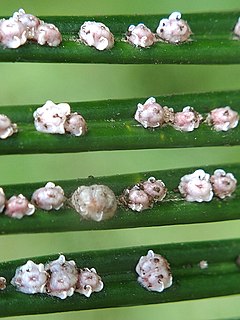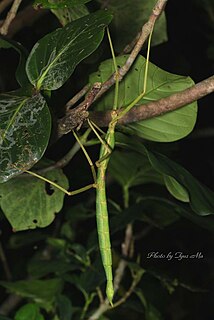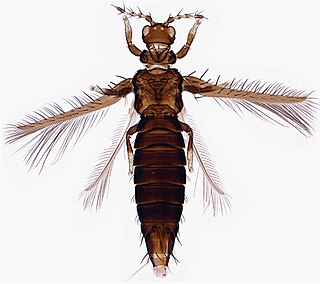Related Research Articles

The Psychidae are a family of the Lepidoptera. The bagworm family is fairly small, with about 1,350 species described. Bagworm species are found globally, with some, such as the snailcase bagworm, in modern times settling continents where they are not native.

The Sphingidae are a family of moths (Lepidoptera), commonly known as hawk moths, sphinx moths, and hornworms; it includes about 1,450 species. It is best represented in the tropics, but species are found in every region. They are moderate to large in size and are distinguished among moths for their agile and sustained flying ability, similar enough to that of hummingbirds as to be reliably mistaken for them. Their narrow wings and streamlined abdomens are adaptations for rapid flight. The family was named by French zoologist Pierre André Latreille in 1802.

The insect order Zoraptera, commonly known as angel insects, contains a single family, the Zorotypidae, which in turn contains one extant genus Zorotypus with 44 extant species and 11 species known from fossils. They are small and soft bodied insects with two forms: winged with wings sheddable as in termites, dark and with eyes (compound) and ocelli (simple); or wingless, pale and without eyes or ocelli. They have a characteristic nine-segmented beaded (moniliform) antenna. They have mouthparts adapted for chewing and are mostly found under bark, in dry wood or in leaf litter.

Scale insects are small insects of the order Hemiptera, suborder Sternorrhyncha. Of dramatically variable appearance and extreme sexual dimorphism, they comprise the superfamily Coccoidea. Adult females typically have soft bodies and no limbs, and are concealed underneath domed scales, extruding quantities of wax for protection. Some species are hermaphroditic, with a combined ovotestis instead of separate ovaries and testes. Males, in the species where they occur, have legs and sometimes wings, and resemble small flies. Scale insects are herbivores, piercing plant tissues with their mouthparts and remaining in one place, feeding on sap. The excess fluid they imbibe is secreted as honeydew on which sooty mold tends to grow. The insects often have a mutualistic relationship with ants, which feed on the honeydew and protect them from predators. There are about 8,000 described species.

The order Embioptera, commonly known as webspinners or footspinners, are a small group of mostly tropical and subtropical insects, classified under the subclass Pterygota. The order has also been called Embiodea or Embiidina. More than 400 species in 11 families have been described, the oldest known fossils of the group being from the mid-Jurassic. Species are very similar in appearance, having long, flexible bodies, short legs, and only males having wings.

The forest bug or red-legged shieldbug is a species of shield bug in the family Pentatomidae, commonly found in most of Europe. It inhabits forests, woodlands, orchards, and gardens.

Dryinidae is a cosmopolitan family of solitary wasps. Its name comes from the Greek drys for oak: Latreille named the type genus Dryinus because the first species was collected in an oak plant in Spain. The larvae are parasitoids of the nymphs and adults of Auchenorrhyncha. Dryinidae comprises approximately 1900 described species, distributed in 17 subfamilies and 53 genera.

Eurybrachidae is a small family of planthoppers with species occurring in parts of Asia, Australia and Africa. They are remarkable for the sophistication of their automimicry.

Phyllocrania paradoxa, common name ghost mantis, is a small species of mantis from Africa remarkable for its leaf-like body. It is one of the three species in the genus Phyllocrania. It is known for its distinct and exclusive camouflaged appearance of a dry weathered leaf.
Archipsocus nomas is a web-spinning barklouse, a psocid in the insect family Archipsocidae. It is found in the southeast of the United States, living gregariously on trees, feeding on and lichen and fungi and spinning a web that adheres to the trunk and large branches in sheets. The webs are thought to protect the barklice from predators and neither the insects nor the webs cause damage to the trees.

The dark bush-cricket is a flightless species of bush-cricket.

Tamarixia radiata, the Asian citrus cyllid parasitoid, is an hymenopteran wasp from the family Eulophidae which was discovered in the 1920s in the area of northwestern India (Punjab), now Pakistan. It is a parasitoid of the Asian citrus psyllid, an economically important pest of citrus crops around the world and a vector for Citrus greening disease.
Oligotoma nigra, also known as the black webspinner, is a species of insect in the order Embiidina, also known as Embioptera.

Oligotoma saundersii, commonly known as Saunders' embiid, is a species of webspinner, an insect in the order Embiidina, also known as Embioptera.

Oligotomidae is a family of webspinners in the order Embioptera. There are about 6 genera and at least 40 described species in Oligotomidae.
Zorotypus hubbardi, commonly known as Hubbard's angel insect, is a species of insect in the order Zoraptera. It is native to the tropical and subtropical New World and has expanded its range into the eastern United States, where it lives in piles of sawdust, whereas in the hotter part of its range it lives under the bark of decomposing logs. It was named after the American entomologist Henry Guernsey Hubbard, who discovered the insect in the United States.
Antipaluria urichi is a species of webspinner in the family Clothodidae. It is found in the Caribbean region and South America, the type locality being the island of Trinidad.

Phasmotaenia lanyuhensis is a species of stick insect, order Phasmatodea. It is endemic to Taiwan. It is often included in the family Phasmatidae, although sometimes excluded from it when the family is strictly delimited. It derives its specific name from its type locality, Lanyuh Island, commonly known as Orchid Island.

Selenothrips rubrocinctus, commonly known as the redbanded thrips, is a species of thrips in the family Thripidae. It was first described from the West Indies but may have originated in northern South America. It has spread to other parts of the world and now has a near pan-tropical distribution, occurring in North, Central, and South America, Africa, southern Asia, and Australasia.

Pachyrhamma edwardsii is a species of wētā, in the family Rhaphidophoridae, endemic to New Zealand. This species is found in caves, or large cavities where there is high humidity and little plant or animal life.
References
- 1 2 3 Poolprasert, P.; Sitthicharoenchai, D.; Butcher, B.A. (2011). "Aposthonia Krauss, 1911 (Embioptera: Oligotomidae) from Thailand, with description of a new species". Zootaxa . 2937: 37–48. doi:10.11646/zootaxa.2937.1.3.
- ↑ "Aposthonia ceylonica (Enderlein, 1912)". Global Biodiversity Information Facility . Retrieved 2 March 2019.
- 1 2 "Webspinners: the UK's first new insect for 100 years". The Guardian . 1 March 2019.
- ↑ Ross, E.S. 2009. Embiidina. Pages 315-316 in Encyclopedia of Insects, V. H. Resh and R. T. Cardé, eds. Academic Press.
- ↑ Briggs, Helen (27 February 2019). "Webspinners: New order of insects sets up home in UK". BBC News . Retrieved 2 March 2019.
- 1 2 Foottit, Robert G.; Adler, Peter H. (2018). Insect Biodiversity: Science and Society. Wiley. p. 228. ISBN 978-1-118-94559-9.